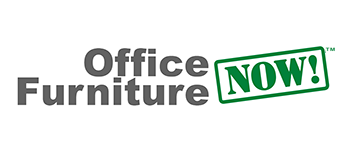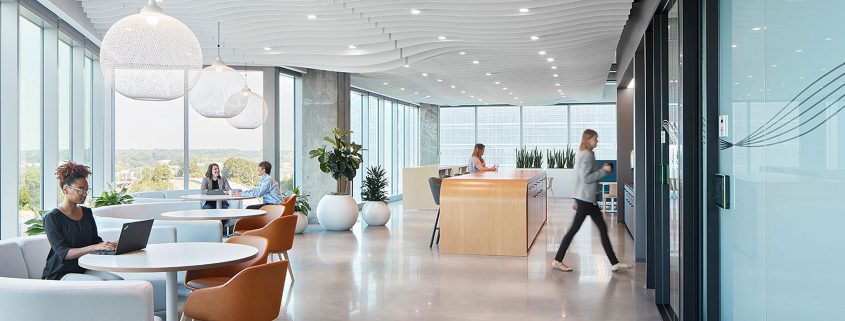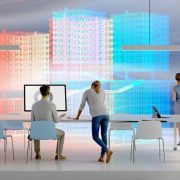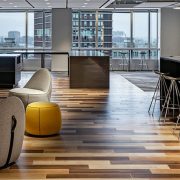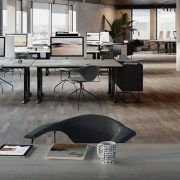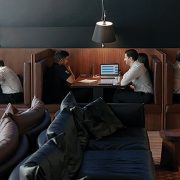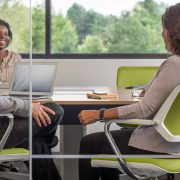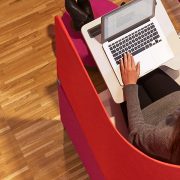Adjusting To Adaptive Workspaces
Adaptive workspaces are designed to be flexible and versatile to accommodate the changing needs of your business. As the landscape of the future of work keeps evolving and adapting, office design will seek trends to futureproof your work environment.
If flexible work has decreased your person per capita of space, creatively transiting the use of that extra space is an opportunity to rethink not only how you operate, but how you brand. Remote work, hybrid work, and other forms of flexible working encourage adaptive layouts that focus on non-descript collaborative zones that can accommodate a range of activities throughout the day, regardless of location:
- Modular layouts with hotdesking, standing desks, and breakout zones
- Flexible workstations that can be rearranged to suit different situations
- Adaptable technology infrastructures so devices can easily be connected to the networks
- Mobile/remote work support such as video conferencing facilities
- Versatile meeting spaces from conference rooms to huddle rooms
- Multi-functional common areas for flexible work, team meetings, events, and social gatherings
OFFICE UNSTRUCTURED
If you think about it, long before the disruption of the last few years, unstructured collaboration happened in the office on some level every day through random conversations. Branding and company culture have always been created and nurtured within the office. Workspaces are still necessary, they are where important strategic decisions occur. And where significant HRM encounters happen. Organizing, coordinating, and managing people still needs to happen. Time spent in the office still has to accommodate:
- Concentrated, focused work
- Group, collaborative work
- Socializing
- Organic and structured learning
Even with remote work, people from different departments still need to be able to interact, solve complex problems, and generate innovative new ideas. While you cannot plan for creative sparks, you can make them more likely to happen by creating the right office design that encourages impromptu conversations.
The pandemic reminded us that the office is where experiences happen rather than where tasks get done. Unstructured collaboration isn’t possible when everyone is working from home. Adaptive workspaces can quickly flex to your team’s needs. Strive to innovate the layout, design, and useability of every square foot of the space.
FLEXIBLE WORKFLOWS
Working in flexible spaces supports workflows of all shapes and sizes. Leveling the playing field by creating opportunities for growth should include every department, including the more structured groups like accounting.
Focus on adapting to the workflow of their user, not the other way around.
In one study performed by Clutch, a data-driven market insight firm, over half (53%) of all workers surveyed stated that they valued flexibility in the office to support their productivity and quality of work. This statistic makes workplace flexibility the second-most-valued quality in a work environment, after an aesthetically pleasing and comfortable workspace.
The same study also found that “around 73% of workers agree that office appearance and work environment greatly influences where they choose to work.”
DESIGN WITH INTENTION
A design with intention creates a different dynamic altogether. Integrating innovative space planning with a fresh design that includes your brand aesthetic gives purpose to the time spent in the office. Residential design is still dominating with unique, comfortable, and inspiring spaces that create a sense of calm and put people at ease.
According to Tracy Haugen, author and director at Deloitte Consulting, 1 in 3 workers say that being able to integrate work and life is the most important factor in choosing a job. Office design must still accommodate spaces for focused work as well as interactive spaces for collaboration.
The design and built environment of any given workspace directly reflects the company culture. Incorporating unconventional workspaces in office buildings signals a firm’s dedication to balancing personal and professional. Another benefit of creating communal workspaces is the ease of knowledge exchange. Ultimately, flexible offices offer a solution to encouraging creative problem-solving, cultivating a sense of community, and redefining the workplace.
TAKEAWAYS
As workspace design continues to evolve, flexibility is non-negotiable. Adaptable and modular workspaces encourage efficient operations, optimal job satisfaction for employees, and support agile environments. Well-designed adaptable office spaces have the potential to holistically support both the organization’s and employees’ needs at any level of growth. No matter what size your office team is these days, adaptive design is important to keep your team productive and engaged.
It is important that business leaders analyze what transition is best at an individual, team, and organizational level to make the most effective design choices. Our project managers and designers can help you navigate these changes and explore options for your adaptive workspace. Visit our Inspired Workspaces boards for some ideas!
And remember, your employees’ ideal mix of experiences and variety of work settings must now include a workplace ecosystem beyond the office.
JLL Charlotte, Charlotte, North Carolina. Photo: ©Mark Herboth Photography LLC
 OUR PROJECT MANAGEMENT TEAM is experienced and educated in a variety of tools and methodologies to help you visualize your design, reconfiguration, or relocation project. Once you contact us, and we understand your vision, requirements, and budget. Contact us at 512-448-3769 or experts@officefurniturenow.com
OUR PROJECT MANAGEMENT TEAM is experienced and educated in a variety of tools and methodologies to help you visualize your design, reconfiguration, or relocation project. Once you contact us, and we understand your vision, requirements, and budget. Contact us at 512-448-3769 or experts@officefurniturenow.com
